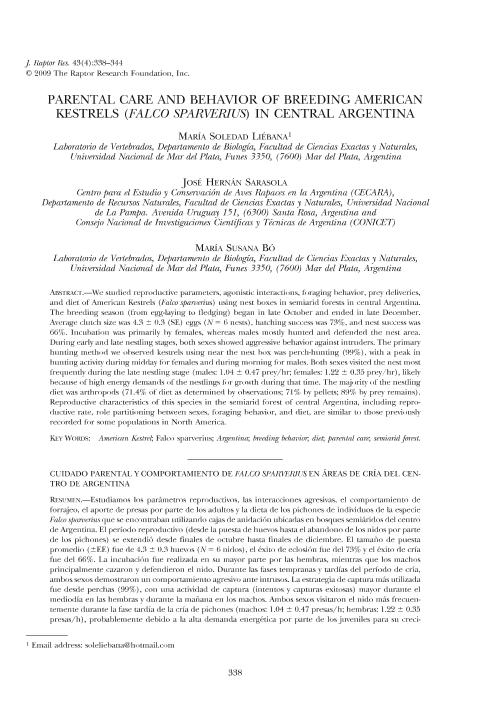Artículo
Parental care and behavior of breeding American Kestrels (Falco sparverius) in central Argentina
Fecha de publicación:
12/2009
Editorial:
BioOne
Revista:
Journal of Raptor Research
ISSN:
0892-1016
Idioma:
Inglés
Tipo de recurso:
Artículo publicado
Clasificación temática:
Resumen
We studied reproductive parameters, agonistic interactions, foraging behavior, prey deliveries, and diet of American Kestrels (Falco sparverius) using nest boxes in semiarid forests in central Argentina. The breeding season (from egg-laying to fledging) began in late October and ended in late December. Average clutch size was 4.3 ± 0.3 (SE) eggs (N 6 nests), hatching success was 73%, and nest success was 66%. Incubation was primarily by females, whereas males mostly hunted and defended the nest area. During early and late nestling stages, both sexes showed aggressive behavior against intruders. The primary hunting method we observed kestrels using near the nest box was perch-hunting (99), with a peak in hunting activity during midday for females and during morning for males. Both sexes visited the nest most frequently during the late nestling stage (males: 1.04 ± 0.47 prey/hr; females: 1.22 ± 0.35 prey/hr), likely because of high energy demands of the nestlings for growth during that time. The majority of the nestling diet was arthropods (71.4% of diet as determined by observations; 71% by pellets; 89% by prey remains). Reproductive characteristics of this species in the semiarid forest of central Argentina, including reproductive rate, role partitioning between sexes, foraging behavior, and diet, are similar to those previously recorded for some populations in North America.
Archivos asociados
Licencia
Identificadores
Colecciones
Articulos(INCITAP)
Articulos de INST.D/CS D/L/TIERRA Y AMBIENTALES D/L/PAMPA
Articulos de INST.D/CS D/L/TIERRA Y AMBIENTALES D/L/PAMPA
Citación
Liébana, María Soledad; Sarasola, José Hernán; Bó, Maria Susana; Parental care and behavior of breeding American Kestrels (Falco sparverius) in central Argentina; BioOne; Journal of Raptor Research; 43; 4; 12-2009; 338-344
Compartir
Altmétricas




